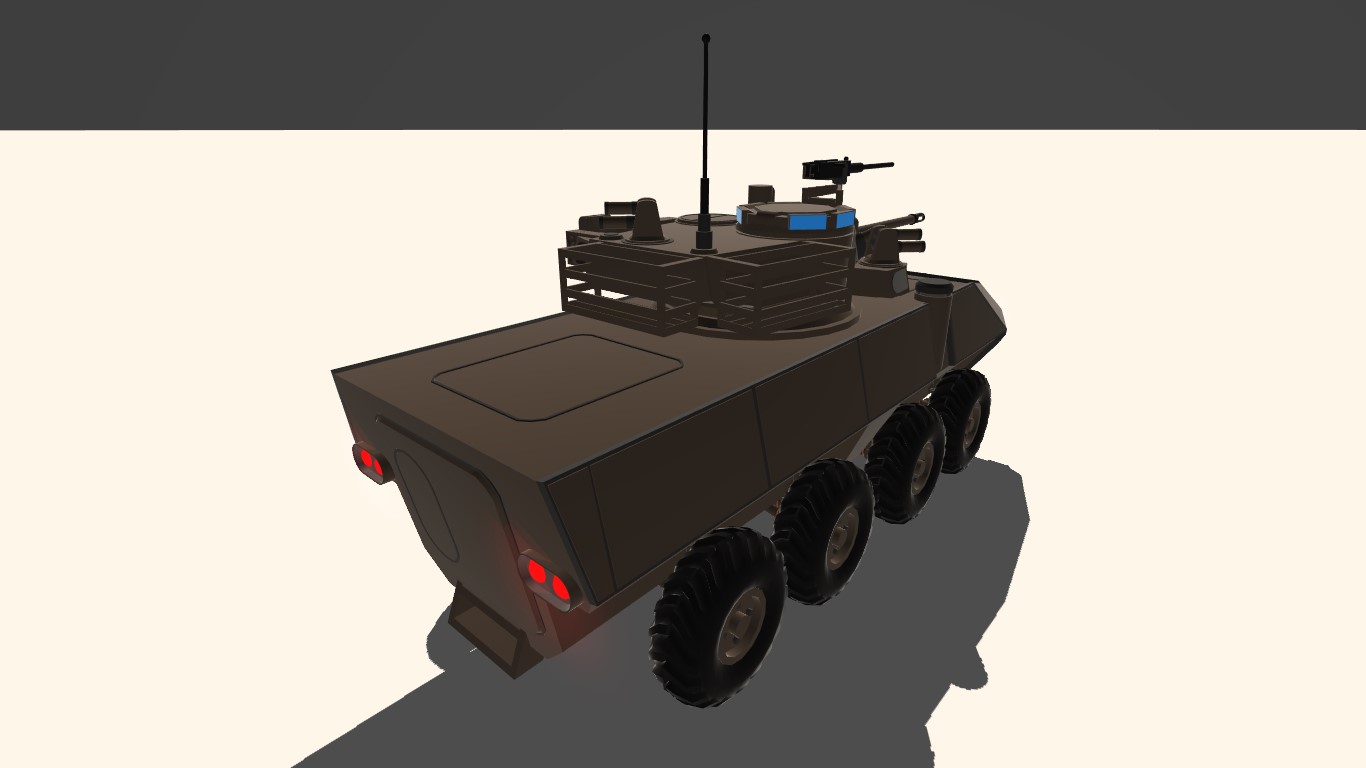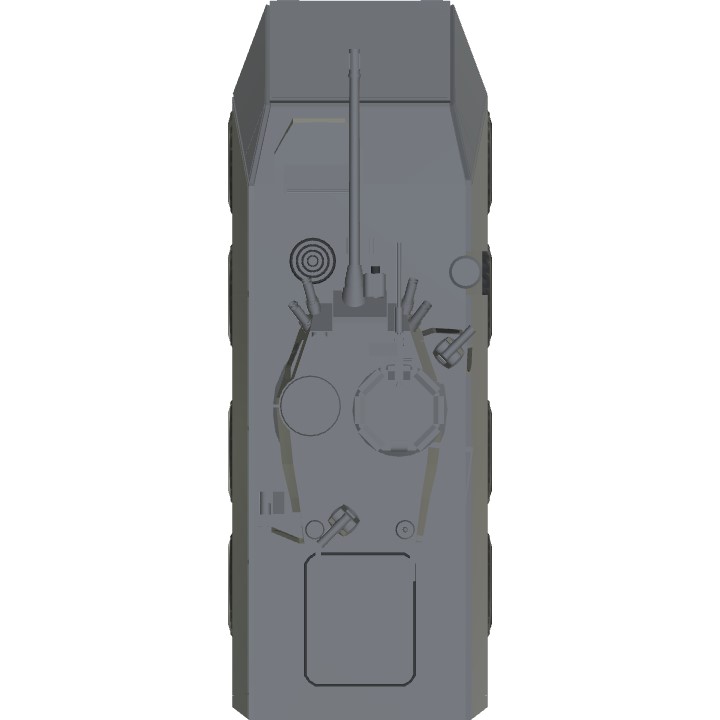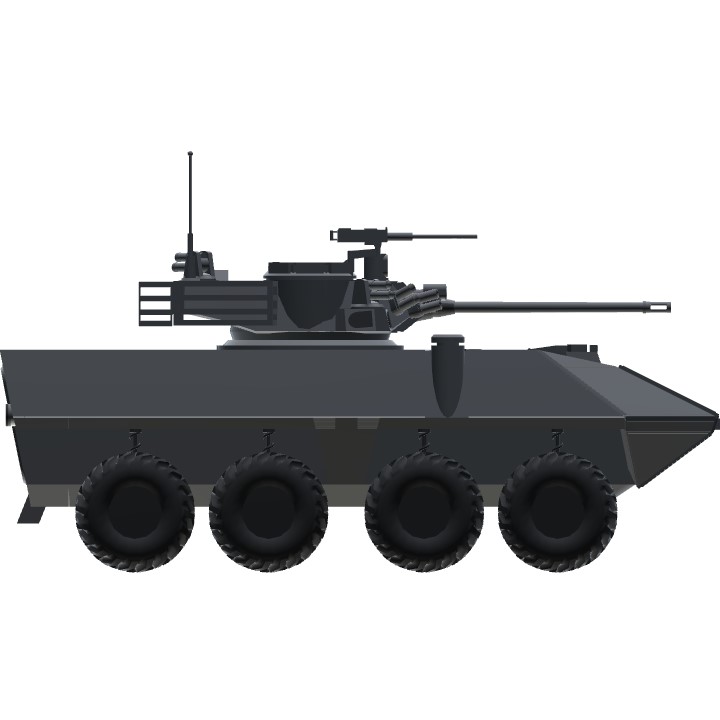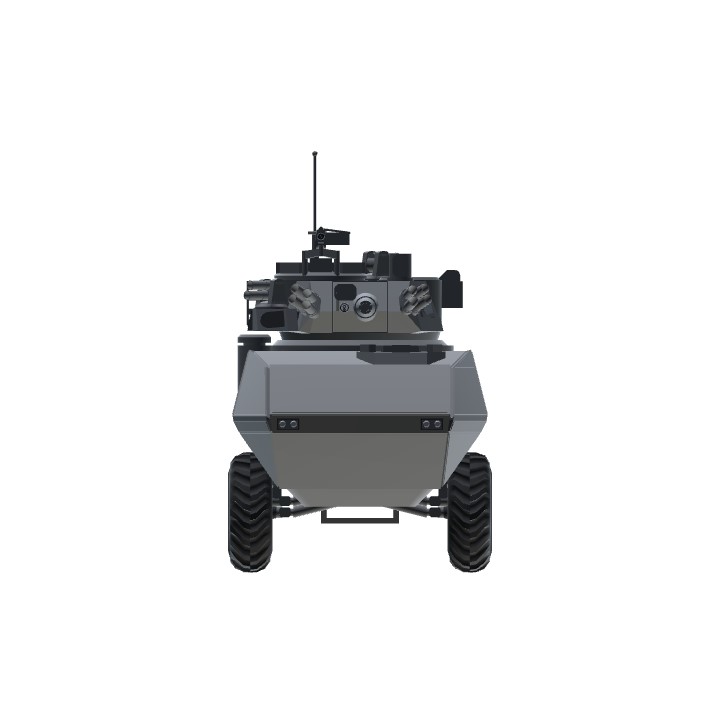OBSOLETE
Click here for the updated model.
Instructions:
- VTOL + Yaw to move
- Pitch + Roll to control weapons mount
- (1) activates main turret controls
- (2) activates 30mm M15 cannon
- (3) activates 7.62mm M60E2 GPMG
- (4) activates 12.7mm M2HB HMG
- (5) activates Javelin ATMS
Summary:
The Stallion Wheeled Armored Vehicle is a Paternian 8x8 armored fighting vehicle, designed as a family of wheeled armored vehicles. Developed from the highly successful Light Reconnaissance Vehicle, it would be the ideal solution to a modernizing Paternian military.
This particular example is a Stallion Infantry Fighting Vehicle, armed with a 30mm M15 revolver cannon and a pair of Javelin SACLOS AT missiles(not related to the US Javelin missile).

Conception:
Politics of the second half of the 20th century found the Paternian Armed Forces involved in Africa. From backing the ascension of the Winolian monarchy, the suppression of the Polisario Front in Morocco and Western Sahara, a timely intervention in Liberia, and the infamous drawn-out stalemate in Angola, the Paternian military found itself increasingly involved on the continent. In doing so, it would learn many lessons, often the hard way.
One of those lessons was the value of wheeled armor. Initially, the Paternian Army was fairly adverse to using armored wheeled vehicles, preferring tracked vehicles such as the M125 APC. However, the conflicts the Paternians would find themselves in created a shift in thinking.
The KRIEG M1118 Commando, an armored car developed purely for export, would soon see extensive service with its home nation. Initially used purely for base and convoy security, the machine nonetheless proved an invaluable asset. It served as the do-all be-all of Paternian Army and Marine mechanized infantry units. Short of being a proper tank or self-propelled gun, it did everything it was asked to do and it did it well enough that eventually, the type would be the most common armored fighting vehicle in the Paternian Armed Forces.
However good a design the Commando armored car was, it wasn't perfect. The vehicle's 4x4 drive and rear-mounted engine, combined with certain features like side doors and firing ports, made it hard to modify it for certain roles. While the Commando was the machine the Paternian Army most certainly deserved, it wasn't what it needed.
Design
The Stallion was designed with a modular design in mind, one that can be readily adapted to whatever the situation requires it to do.

Mobility
The Stallion family is an 8-wheeled vehicle, which can choose between an 8x4 where only the rear wheels are driven, or an 8x8 where all wheels are driven. All tires are linked to a central tire inflation system.
It is powered by either a Bandit D8 diesel engine or a KRIEG V6-72D diesel engine. Both are V-6 diesel engines, but the D8 is a 7.6 liter 365hp engine, while the V6-72D is a 7.2 liter 340hp engine. Currently, the D8 diesel is the engine of choice, and both engine options use a Bandit B32 transmission found on the Bandit Danube series of military trucks.
It was initially developed as an amphibious vehicle, but this requirement was later dropped in favor of applique armor. Still, it is capable of fording up to 1.5 meters of water.
Airmobility
The Stallion can be safely delivered by C-17, C-5, or A-400M by either standard high altitude parachute drop or by LAPES. It and the LRV it was derived from are the only Paternian armored amphibious machines capable of doing so with an armament heavier than a .50 caliber machine gun.
An early requirement was that the machine be airdroppable from a C-130. However, this was quickly reverted to air-transportable, as it was pointed out that the lighter LRV couldn’t be airdropped by C-130 either.
Protection
The Stallion's baseline armor is MIL-A-46100 specification high-hardness steel, and is rated to STANAG 4569 Level 3 overall. This will stop 7.62mm NATO tungsten-core AP rounds at 30m, and will allow the vehicle to survive mine blasts.
Stallion Improved Protection System
Additional protection can be sought to improve the ballistic qualities, with the Stallion Improved Protection System (fitted to this example). SIPS comes in two forms, based on the desired ballistic protection.
SIPS I uses a hard weather-proof and splinter-proof nylon outer plates sandwiching multiple aramid layers soaked in Ballistic Plastic Formula 21 (BPF-21). There is a 50mm air gap between the SIPS I plate and the base armor.
SIPS I brings ballistic protection to the front and sides to Level 4, and provides resistance to weapons such as 40mm grenades, rifle grenades, and light anti-tank weapons such as single-warhead RPG-7 projectiles. With the full SIPS I kit weighing 2,350kg on account of the lightweight polymer construction, the capability it provides for this mass is considerable.
SIPS II uses a composite armor matrix consisting of a semi-solid Ballistic Plastic Formula 9 (BPF-9) layer sandwiched between a through-hardened MIL-A-46100 strike plate and a softer through-hardened MIL-A-12560 steel backing plate, with a 25mm air gap between SIPS II armor panels and base armor.
SIPS II being ballistic protection to the front and sides to Level 5, suitable to stop 25mm APDS from the sides. The frontal arc of SIPS II is able to stop 30mm APDS projectiles in similar conditions. It also provides more substantial protection against HEAT projectiles, such as newer single-stage RPG-7 warheads. While providing substantial protection, the cost in terms of weight (6,500kg), monetary cost, and the subsequent strain on automotive components and their lifespan limit the distribution of these kits to those actively deployed in high-intensity areas.
SIPS cannot be completely fitted to the ESV, ABLV, MRV, Zamburak, and CASEVAC variants due to different hull shapes and required external fittings.
Ballistic Plastic
Ballistic Plastic, named for the ease which it can be molded by hand, is a non-Newtonian shear-thickening fluid. Varying mixtures allow for different properties and resting viscosities. It was developed as an alternative to ceramic plate in personal and vehicle armor. Both materials had the required hardness for composite armor systems, but lost these qualities after sustaining multiple hits. This major weakness resulted in several losses of Commando armored cars fitted with ceramic armor.
Over time, several formulas of Ballistic Plastic were developed, and SIPS was the first major application of Ballistic Plastic as a vehicle armor. The numbering has no bearing on the qualities of the Ballistic Plastic itself, but rather the sequence which a formula was approved for use as Ballistic Plastic. There are over 30 distinct formulas, with different material qualities.
Active Protection Systems
The Infantry Fighting Vehicle is fitted with the Gauntlet hard-kill active protection system in order to defeat anti-tank projectiles.
All variants are CBRN protected.
Armament
The Stallion's firepower varies highly among its variants, ranging for GPMGs and HMGs to guided missiles and even gun artillery.
Variants:
The Stallion comes in numerous variants, under the M1220 series:
- M1221 ICV; Infantry Carrier Vehicle, crew of 2, troop carrier with a capacity of up to 14 dismounts. Armed with RCWS.
- M1221B ICV-MCT; Infantry Carrier Vehicle - Medium Caliber Turret. Armed with KRIEG Medium Caliber Turret, fitted with 30mm cannon. MCT is remotely operated and does not take up internal space, save for compact control panel. Passenger capacity is identical.
- M1222 IFV; Infantry Fighting Vehicle; crew of 3, troop carrier with a capacity of up to 12 dismounts. Paternian Army machines are configured for 9 for increased comfort and additional storage. Armed with Medium Weapons Turret with 30mm M15 autocannon and coaxial GPMG.
- M1222B IFV-AT; Infantry Fighting Vehicle - Anti Tank. Variant armed with Javelin missiles.
- M1223 Skysweeper; Self-propelled air defense vehicle, crew of 3. Armed with two 30mm M15 revolver cannons and eight Sentinel MANPADS. Electro-optical fire control with radar search/tracking.
- M1224 ATMC; Anti Tank Missile Carrier, crew of 3. Armed with two Javelin ATGM with 10 reloads.
- M1225 MRV; Maintenance and Recovery Vehicle, crew of three with room for up to four. Features A-frame crane and 10-ton winch. With double tackle, winch is rated for 40 tons. Earth anchor is available for use to secure position into ground. Armed with 12.7mm HMG.
- M1226 ESV; Engineering Support Vehicle, crew of three engineers with room for four sappers. Equipped with either straight anti-obstacle plow, anti-mine plow, or anti-mine rollers. Includes lane markers to indicate cleared area in minefield. Armed with 12.7mm HMG.
- M1227 ABLV; Armored Bridgelaying Vehicle, crew of four. Equipped with 12-meter assault bridge. Armed with 12.7mm HMG, rarely fitted in practice.
- M1228 DFSS "Zamburak"; Direct Fire Support System; crew of 3, wheeled assault gun. Armed with 105mm M7 rifled gun or 120mm M9 smoothbore gun, with coaxial GPMG and pintle-mounted HMG.
- M1229 C3; Command, Control, Communications Vehicle, crew of 2 + command staff personnel. Equipped with extra communications systems. Armed with 12.7mm HMG.
- M1230 MC; Mortar Carrier, crew of five. Armed with 120mm Gun-Mortar System, with pintle-mount 12.7mm HMG for self-defense. Carries 81mm mortar for dismounted use.
- M1231 CASEVAC; Casualty Evacuation, crew of two + 2 medics + 10 sitting patients or 4 litters. Unarmed in accordance to international treaties.
- M1232 SPH-155 "Gunslinger"; 155mm howitzer, built on a modified M1228 Zamburak chassis. Armed with 155mm howitzer in KRIEG turret and pintle-mounted HMG.
- M1233 SPH-105; 105mm howitzer, built on standard M1228 Zamburak chassis. Armed with 105mm howitzer in Bandit turret and pintle-mounted HMG.
Winolian variants
- Stallion with CV2000-FS1 Sniper Turret. Role identical to Zamburak.
Operators
- Paternian Armed Forces
- Paternian Army
- Paternian Marine Corps
- Empire of Winolia; licensed production jointly between Marathon Motors and Bishoftu Land Systems
- Royal Paratrooper Regiment
- Awwam
- Royal State of Aleutzia
- Royal Aleuztian Army
Specifications
General Characteristics
- Created On Windows
- Wingspan 10.9ft (3.3m)
- Length 26.6ft (8.1m)
- Height 15.4ft (4.7m)
- Empty Weight 42,410lbs (19,237kg)
- Loaded Weight 42,676lbs (19,357kg)
Performance
- Wing Loading 10,572.8lbs/ft2 (51,620.8kg/m2)
- Wing Area 4.0ft2 (0.4m2)
- Drag Points 10083
Parts
- Number of Parts 585
- Control Surfaces 0
- Performance Cost 2,427







Pabrika Buy this for 21 unit
@Pilotmario Ohhhhh,my bad I'm not used to shoot a gun on the move.
And about the really cool sounding variants that I mentioned? will you make them?,please do it.
@Mmdben Using VTOL + Trim with the weapons turret would inhibit their operation on the move.
M1228 DFSS "Zamburak" , M1230 MC; Mortar Carrier and M1232 SPH-155 "Gunslinger" These will be very cool if you made them! ,also well made description! but the movement controls-why did you choose that set of controls instead of WASD(Pitch, roll,yaw)?